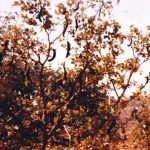Ceratonia siliqua
Uses
Chad (central): fruit eaten. Sudan (Kordofan): pods harvested when ripe, and eaten fresh or dried for later consumption. A beverage is prepared by soaking the pods in water.
Additional Information
- Name Authority:
- L.
- Vernaculars:
- Chad (central) (Arabic): Karroub. Sudan (Arabic): Alkharoub.
- Misc:
- Chemical composition: Protein (crude) = 6.1% (dry). Fat = 2.6% (dry). Fibre (crude) = 2.2% (dry). Ash (insoluble) = 5.1% (dry). Carbohydrate (insoluble): Starch = 1.4% (dry). Sucrose = 0.8% (dry). D-glucose = 0.4% (dry). D-fructose = 0.2% (dry). Amino acids (g [16g N]-1): Aspartic acid = 5.9g. Threonine = 2.5g. Serine = 3.0g. Glutamic acid = 7.8g. Proline = 11.6g. Glycine = 7.4g. Alanine = 3.3g. Cysteine = 1.0g. Methionine = 0.7g. Isoleucine = 2.2g. Leucine = 3.8g. Tyrosine = 2.3g. Phenylalanine = 2.5g. Lysine = 3.0g. Histidine = 1.7g. Arginine = 4.3g. Minerals: Sulphur = 0.10% (dry). Potassium = 0 .09% (dry). Magnesium = 0.09% (dry). Calcium = 0.23% (dry). Na = 0.01% (dry). K = 1.48% (dry). Zinc = 17mg/kg-1 (dry). Iron = 203mg/kg -1 (dry). Manganese = 16mg/kg-1 (dry). Copper = 7mg/kg-1 (dry). Aluminum = 128mg/kg-1 (dry).
